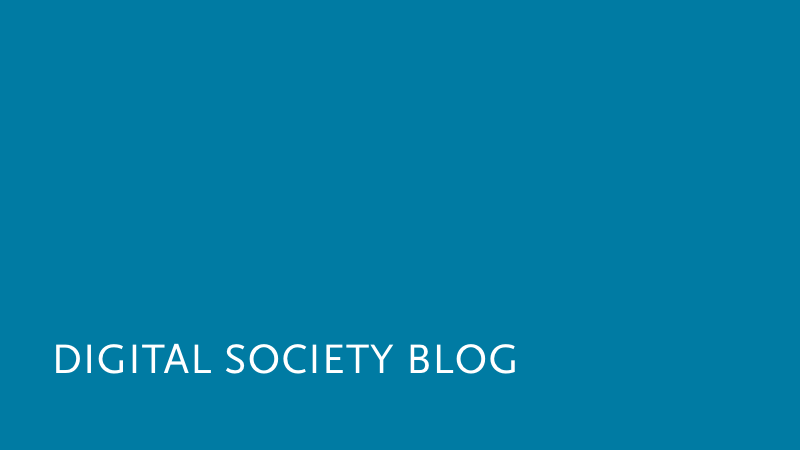Unsere vernetzte Welt verstehen

Three Ways to Understanding Civil Disobedience in a Digitized World
Dieser Artikel ist eine Kurzfassung der Einleitung von Theresa Züger zum internationalen und interdisziplinären Workshop Civil Disobedience Beyond the State II: The Digitalization of Disobedience from Whistleblowing to Anonymous der am 8. und 9. Mai in Berlin stattgefunden hat. Der Workshop ist der zweite Workshop einer Reihe zu Fragen der Transformation von zivilem Ungehorsam. Ein dritter Workshop folgt im November 2015 in Oxford.
The idea of the digitalization of civil disobedience, which was the main theme of the workshop Civil Disobedience Beyond the State II: The Digitalization of Disobedience from Whistleblowing to Anonymous appears to be a straightforward concept. But in fact, behind the semantic facade, it’s rather messy. It combines very different types of action, that range from DDos actions to actual hacking, from parodistic websites or web defacements to whistleblowing or counter surveillance measures and various others.
Digital disobedience – like civil disobedience in general – turns out to be a quite contested concept. Not only is there a wide range of practices to talk about, there are also different understandings of civil disobedience that make it even more challenging to come to a common discourse. Through the lenses of different disciplines, there are quite different angles to approach this topic. This articles aims to sketch out three dominant approaches to understanding the digitalization of civil disobedience: first, by understanding it as a social practice, second by deploying a narrow definition of civil disobedience to digital actions and third by applying a (comparably) wide definition of civil disobedience.
The first approach is to look at digital tactics of disobedience as a social practice.
This approach is so far the most prominent and is mostly applied among disciplines such as sociology, anthropology or social movements studies, which were also the first to pay attention to the emergence of new forms of digital disobedience. Their empirical approach describes new types of digital actions researching their internal logic but at the same time framing them according to the established concepts of protest and dissidence in this research field. The key term to describe digital disobedience as a social practice is the concept of hacktivism.
Remarkably, from this empirical perspective, digital disobedience or electronic civil disobedience (as it was called by the Critical Art Ensemble, who were often viewed as the progenitors) is not treated as an independent concept. Many definitions and implicit assumptions often frame it as a sub-category of hacktivism or even use both concepts interchangeably. In Dorothy Denning’s (2001: 263) view “Hacktivism is the convergence of hacking with activism […] Hacktivism includes electronic civil disobedience”. Hacking is thereby seen as the pursuit of technological mastery as an end in itself, whereas hacktivism introduces a new kind of political objective. In his article Mapping Hacktivism, Tim Jordan (2001: 8) views electronic civil disobedience as a certain type of hacktivism, which he calls Mass Virtual Direct Action, describing it as the “simultaneous use, by many people, of the Internet to create electronic civil disobedience”.
Researching digital disobedience as a social practice reveals a wide range of insights about the new performative paradigms, different motivations and cultures behind these actions (as we learned in the public lecture by Gabriella Coleman), and new modes of collectivity (as Joss Hands presented in this workshop). For some digital activists, the use of technologies for protest turns out to be more than a toolbox; it constitutes part of their lives and identities. The actual practices of digital disobedience are one key to coming to terms with what civil disobedience might be in a digitized world.
Nevertheless, the idea of electronic civil disobedience is inspired by established practices associated with civil disobedience – such as sit-ins – rather than by a philosophical understanding of civil disobedience. The question of whether and how new practices of digital disobedience can be understood in the tradition of philosophical thought about civil disobedience is a different question that comes into play.
The second approach is to look at digital practices of disobedience with a set of criteria as a narrow definition of civil disobedience.
This fixed set of criteria, which defines civil disobedience quite narrowly, is mainly inspired by what is known as a liberal understanding of civil disobedience. This understanding was most prominently introduced by John Rawls in A Theory of Justice – where Rawls discusses justice in the framework of an ideal theory of a democratic state.He understands civil disobedience as an exception occurring in a well ordered or nearly just society that is otherwise built on the duty of citizens to obey the law.
Rawls (1971: 320ff) defines civil disobedience as “a public, nonviolent, conscientious yet political act contrary to law usually done with the aim of bringing about a change in the law or policies of the government”. In his understanding civil disobedience is a symbolic appeal to the “sense of justice of the majority,” carried out in “the limits of fidelity to law” which for instance means that the dissident should willingly accept a possible penalty.
An example that applies this definition to digital action was given by Evgeni Morosov in a series of articles, one of which was called In Defense of DDoS. In general he argues that “DDoS attacks can be seen as a legitimate expression of dissent, very much similar to civil disobedience”. Also, regarding the case of the Paypal 14, he claims that the DDoS actions by Anonymous fit Rawls defining criteria – except for one: Anonymous didn’t intentionally reveal the identities of individual actors and thereby didn’t accept the legal consequences of the action. Through the lenses of liberal theory, this action does not promote a fidelity to law – and therefore Morozov concludes that these actions cannot be seen as civil disobedience.
Whether one agrees with Morozov or not, the liberal perspective on new forms of digital disobedience leads us to many open and interesting questions: Given all technical restrictions to actual anonymity,
can legitimate civil disobedience take place anonymously at all, and if yes, under what conditions? What kind of communicative efforts should be taken to address the public for an action to be a permissible digital act of civil disobedience? And what do we mean exactly by “public” in a digital context for civil disobedience?
Another arising issue is what cases of digital disobedience can teach us about the relationship between civil disobedience and the law. If civil disobedience is presumed to express fidelity to the rule of law (as also proposed by Bill Scheuerman in our workshop) what do we think about cases in which the civilly disobedient agents are under different or overlapping jurisdictions, so that it is unclear which law the agent is supposedly expressing fidelity to? Addressing this question from her experience with the Electronic Frontier Foundation, Jillian C. York gave us many interesting insights into the very different consequences that digital disobedience might have in different national contexts.
The third approach is to look at digital practices of disobedience with a wide definition of civil disobedience.
This approach depends on a different understanding of civil disobedience, one that is less restrictive compared to the liberal concept regarding the criteria for definition. In this second tradition of thinking about civil disobedience, often called a radical democratic approach, Robin Celikates proposed a minimal understanding of civil disobedience. He suggests thinking of civil disobedience as
“an intentionally unlawful and principled collective act of protest (…) that (…) has the political aim of changing (a set of) laws, policies, or institutions” (Celikates, forthcoming).
According to this notion neither the criteria of non-violence or publicness nor the idea that disobedient actors are required to accept their punishment plays a role in defining something as civil disobedience. For the discussion about the justification of an act of civil disobedience at least the first two points certainly do matter. But compared to the liberal approach, these acts are evaluated in a more general discussion on how compatible with democracy a concrete act of civil disobedience is in its specific context and how democratically it is enacted in itself.
There are quite a few actions than fall into this definition of digital acts of civil disobedience, like these three examples:
- The BTX Hack. This was a protest action in 1984 against a service of the Deutsche Post called Bildschirmtext. Wau Holland and Steffen Wernery, two founders of the Chaos Computer Club (CCC), who found the BTX system to be insecure, transferred 135,000 DM from an account held by a Hamburg-based bank to the account of the CCC. They returned the money and explained the reasons behind their actions to the public (for instance in the news on television). It took until 2001 until this service was replaced, but ever since, the CCC has been respected as a group of experts on IT Security.
- Crypto Disobedience. As part of a broader conflict often referred to as the Crypto Wars, in 1995 the Cypherpunks encouraged civil disobedience against a US law on the export of cryptography. Until 1996, as far as export restrictions were concerned cryptographic code had the same legal status as munitions, and until 2000 export required a permit. They coded a small crypto-algorithm for public-key cryptography and suggested that people spread it across borders as an email signature file or print it on a T-shirt when crossing borders.
- Grey Tuesday. This act of protest defended a remix album called the Grey Album by DJ Danger Mouse, which combined the White Album by the Beatles with the Black Album by JC. The record company EMI prohibited the distribution of this album. In February in 2014 the non-profit organization Downhill Battle organized a collective act of civil disobedience to protest against the copyright doctrine that excludes music sampling from the fair use policy. In this act of civil disobedience 170 websites participated by offering the Grey Album for download – and about 100,000 downloads occurred that day.
But there are also a lot of cases that remain in a somewhat grey area that requires a deeper discussion, even if we take this wide definition as a baseline. These include individual hacks and also DDoS actions (even though my objections would be different than those introduced by Morosov).
Also, whistleblowing is seen as a type of civil disobedience for good reasons as we learned in a presentation by Manohar Kumar– but organizations or actors in this field barely use this concept and some even reject it. One might argue – as Geoffroy de Lagasnerie did at our workshop and in his book – that actors like Assange, Manning and Snowden stand for a new form of political action (other than civil disobedience) that should also be recognized by political theory as something new: as acts of citizens of democracy.
Why the idea of civil disobedience (still) matters
Bearing these difficulties around the concept of digital disobedience in mind, one might ask (and we did intensively in our Workshop): Why should we keep using the term civil disobedience in the context of digital action and in general? What do we gain by referring to this concept, if there seems to be no common definition and application? Even different activist groups position themselves very differently in relation to the concept of civil disobedience, from total rejection to strategic use or entirely new conceptualizations. Why shouldn’t we simply stick to the terms “whistleblowing” or “hacktivism”?
The concept of civil disobedience might be fuzzy, the practices hard to pin down and its justifiability a controversial issue for each case that arises. But it is precisely this controversial nature in combination with a rich connection to democratic theory that lends it some strengths:
- There might be no general agreement on how to define civil disobedience exactly but there is a widespread agreement that there is a such thing as civil disobedience and that it has a value for human society even though it means to intentionally break a law (which is pretty amazing).
- The actions referred to with concepts such as hacktivism and also whistleblowing have some overlap with civil disobedience, but they do not always imply breaking a law, nor do they introduce the same rich tradition of thought that civil disobedience involves to evaluate this delicate type of political action from a democratic perspective.
- The fact that civil disobedience is an intrinsically ambiguous concept keeps contestation going and this gives new reasons for public debate and redefinition. Despite its contestation (or even because of it), the term civil disobedience can be seen as a marker for public debate. It deserves attention for being a very special type of protest because of the risk actors are willing to take for their cause in the interest of a common world.
After all, civil disobedience is in essence a dynamic concept, which is a pretty good thing for a concept that is intended to stay meaningful in a world moving as fast as ours.
This article is a shortened version of the introduction Theresa Züger gave at the international and interdisciplinary workshop Civil Disobedience Beyond the State II: The Digitalization of Disobedience from Whistleblowing to Anonymousthat took place 8-9 May in Berlin. The workshop was the second of a series of three workshops on the transformation of civil disobedience. A third one will be held in November 2015 in Oxford.
Dieser Beitrag spiegelt die Meinung der Autorinnen und Autoren und weder notwendigerweise noch ausschließlich die Meinung des Institutes wider. Für mehr Informationen zu den Inhalten dieser Beiträge und den assoziierten Forschungsprojekten kontaktieren Sie bitte info@hiig.de

Jetzt anmelden und die neuesten Blogartikel einmal im Monat per Newsletter erhalten.
Offene Hochschulbildung
Freundlich, aber distanziert: Die unbeabsichtigten Folgen KI-generierter E-Mails
KI-generierte E-Mails sparen Mitarbeitenden Zeit und erleichtern den Arbeitsalltag. Aber verlieren wir dadurch unsere Kommunikationsfähigkeiten?
KI am Mikrofon: Die Stimme der Zukunft?
Von synthetischen Stimmen bis hin zu automatisch erstellten Podcast-Folgen – KI am Mikrofon revolutioniert die Produktion digitaler Audioinhalte.
Haben Community Notes eine Parteipräferenz?
Dieser Artikel analysiert, ob Community Notes Desinformation eindämmen oder ob ihre Verteilung und Bewertung politische Tendenzen widerspiegeln.
























